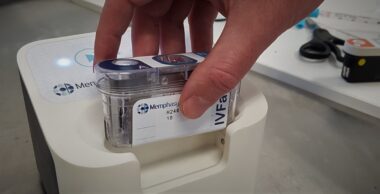- Invasive meningococcal disease (IMD) is rare and most people survive.1 However, even with appropriate medical care, up to 1 in 10 patients with IMD may die, typically within 24-48 hours of symptom onset.2 Up to 1 in 5 survivors may develop long-term disabilities.3
- In 2023, 143* cases of IMD were reported in Australia.4
- Although the bacteria that causes IMD is not easily spread from person to person, the risk of transmission can be increased if there is close and prolonged contact with a person carrying the bacteria.5
- Early symptoms of IMD may be difficult to recognise, as they may be similar to a flu-like illness.6 The distinctive red or purple rash is an advanced symptom of the blood infection, which may or may not occur.5
- Approximately 10% of the general population carry the bacteria at any one time,7 however, this varies by age, and typically peaks in adolescents and young adults.1 Most people will not become ill from carrying the bacteria, however, in a small number of people, the bacteria can cause disease.8
- While meningococcal disease can occur at any age, children less than 2 years of age, and adolescents and young adults aged 15–24 years, are most at risk.9
_________________________________________________________________________
12 April 2024, Melbourne, Australia: As students close their books and turn their attention to catching up with friends and extended families these school holidays, social activities are expected to peak. Experts are advising families to refresh their knowledge of the signs and symptoms of invasive meningococcal disease (IMD) these autumn school holidays. Cases of IMD typically peak in winter and early spring, however, they can occur at any time of year.1
IMD is a rare but potentially devastating bacterial infection, which can start suddenly and become serious very quickly.6 Whilst most people survive, up to 1 in 5 survivors may develop long-term disabilities (which may include brain damage, deafness, loss of limb(s) and nervous system problems).3
Given the disease’s sudden nature, Dr Charlotte Hespe, GP and Professor of General Practice and Primary Care Research, Sydney School of Medicine, University of Notre Dame Australia, points out that knowledge around IMD signs and symptoms is important for all. Especially, as it is not fully understood why disease develops in some individuals but not in others.
"Although IMD is rare, approximately 10% of people can carry the bacteria without showing illness or symptoms. Adolescents and young adults typically have the highest rate of meningococcal carriage in the general population, and are thought to play an important role in transmitting the bacteria in the community,” says Dr Hespe.
“The bacteria is not spread easily from person to person. However, the risks of transmitting the bacteria can be increased if there is close and prolonged contact between individuals, which we may observe during school breaks as people spend free time together. So, it is critical that all Australians, especially young people and their families, educate themselves about the early signs and symptoms of IMD,” she says.
Meningococcal bacteria is spread by tiny drops of fluid from the nose and throat via coughing, sneezing and spluttering.8 Early signs and symptoms can be difficult to diagnose as they may be similar to a flu-like illness.6 Symptoms of IMD may include sudden onset of fever, headache, neck stiffness, joint pain, rash of red-purple spots or bruises, dislike of bright lights and nausea and vomiting.5 The distinctive purple or red meningococcal rash is an advanced symptom of blood infection, which may or may not occur.5 Young children may have less-specific symptoms including irritability, difficulty waking, high-pitched crying and refusal to eat.5
Anyone can develop IMD, but some people are at a higher risk than others. Living in close or prolonged contact with people who may be carrying the bacteria (e.g. university students living in residential colleges), can increase the risk of carrying the bacteria.1 Other risk factors include smoking or being exposed to smoke, having had a recent viral upper respiratory tract illness, and kissing (especially with more than one partner).5
At the end of March 2024, there have been 25* reported cases of IMD nationally, with almost half of the cases originating from NSW and VIC combined (5* and 5* respectively).4 Australia has observed increasing case numbers in recent years (127 in 2022 vs 143* in 2023).4,10
Karen Quick, CEO of Meningitis Centre Australia, says that being equipped with IMD knowledge can potentially save a life as time is of the essence when it comes to minimising the potentially devastating consequences of this disease.
"It is important for all Australians to be aware of the early signs and symptoms of meningococcal disease, especially students aged 15-24, who are one of the most at-risk age groups," Ms Quick says. “While meningococcal disease can occur at any age, children less than 2 years of age, and adolescents and young adults aged 15–24 years are most at risk.”
“The autumn holidays are a good reminder for all Australians to practice good hygiene practices such as handwashing, coughing or sneezing into your elbow and discarding used tissues correctly, to help prevent the spread of germs.
If you think you or someone you know is showing the early signs of meningococcal disease, act immediately in seeking urgent medical attention,” said Ms Quick.
For more information about meningococcal, and how you can help protect yourself or your family, speak to your healthcare professional and visit https://knowmeningococcal.com.au/
*2023 and 2024 data is preliminary and subject to change.
ENDS
About invasive meningococcal disease
Invasive meningococcal disease is a rare bacterial infection caused by a bacteria called Neisseria meningitidis.1 There are multiple types (strains) of meningococcal bacteria. Globally, there are 5 serogroups which most commonly cause disease (A, B, C, W and Y).1 Currently in Australia, 3 strains cause the majority of disease (B, W and Y).4
While most people infected will survive and recover, this rare but potentially devastating infection can progress rapidly and lead to serious disability (up to 1 in 5 who survive the disease may suffer long-term complications, which may include, among others, brain damage, deafness or loss of limb/s)3 or death (up to 1 in 10 infected may die) even with appropriate medical care, within 24-48 hours.2
While meningococcal disease can occur at any age, children less than 2 years of age, and adolescents and young adults aged 15–24 years are most at risk.9
Early symptoms of IMD may be non-specific.5 Symptoms may include sudden onset of fever, headache, neck stiffness, joint pain, rash of red-purple spots or bruises, dislike of bright lights and nausea and vomiting.5 The distinctive purple or red meningococcal rash is an advanced symptom of blood infection, which may or may not occur.5 Young children may have less-specific symptoms including irritability, difficulty waking, high-pitched crying and refusal to eat.5
The Know Meningococcal campaign is sponsored by GSK Australia.
About GSK
GSK is a global biopharma company with a purpose to unite science, technology, and talent to get ahead of disease together. Find out more at gsk.com
| Media enquiries | GSK enquiries |
| Kerry Jung 0435 753 618 [email protected] |
Angela Hill 0466 514 894 [email protected] |
References
|
1 |
Australian Immunisation Handbook. Meningococcal disease. https://immunisationhandbook.health.gov.au/contents/vaccine-preventable-diseases/meningococcal-disease, [Accessed March 2024] |
|
2 |
Meningococcal vaccines: WHO position paper; 2011(11);47:521–540 |
|
3 |
Centers for Disease Control and Prevention. Meningococcal Disease Diagnosis, Treatment, and Complications. https://www.cdc.gov/meningococcal/about/diagnosis-treatment.html [Accessed March 2024] |
|
4 |
National Notifiable Disease Surveillance System (NNDSS). Surveillance Dashboard. https://nindss.health.gov.au/pbi-dashboard/ [Accessed April 2024] |
|
5 |
NSW Health, Meningococcal disease fact sheet, 8 August 2022. https://www.health.nsw.gov.au/Infectious/factsheets/Pages/meningococcal_disease.aspx, [Accessed March 2024] |
|
6 |
Centers for Disease Control and Prevention. Meningococcal Disease Signs and Symptoms. https://www.cdc.gov/meningococcal/about/symptoms.html [Accessed March 2024] |
|
7 |
Better Health Channel. Meningococcal Disease; 2019;1-11; https://www.betterhealth.vic.gov.au/health/conditionsandtreatments/meningococcal-disease#how-meningococcal-disease-is-spread [Accessed March 2024] |
|
8 |
The Royal Children’s Hospital Melbourne, Meningococcal Infection, May 2018. https://www.rch.org.au/kidsinfo/fact_sheets/Meningococcal_infection/, [Accessed March 2024] |
|
9 |
NCIRS. Meningococcal vaccines for Australians – factsheet; 2024; https://ncirs.org.au/ncirs-fact-sheets-faqs/meningococcal-vaccines-australians [Accessed March 2024] |
|
10 |
Department of Health and Aged Care. Communicable Diseases Intelligence. 2022 Australian Meningococcal Surveillance Programme Annual Report, Volume 47, 2023. |
GlaxoSmithKline Australia Pty Ltd ABN 47 100 162 481, Melbourne, VIC
©2024 GSK group of companies or its licensor



